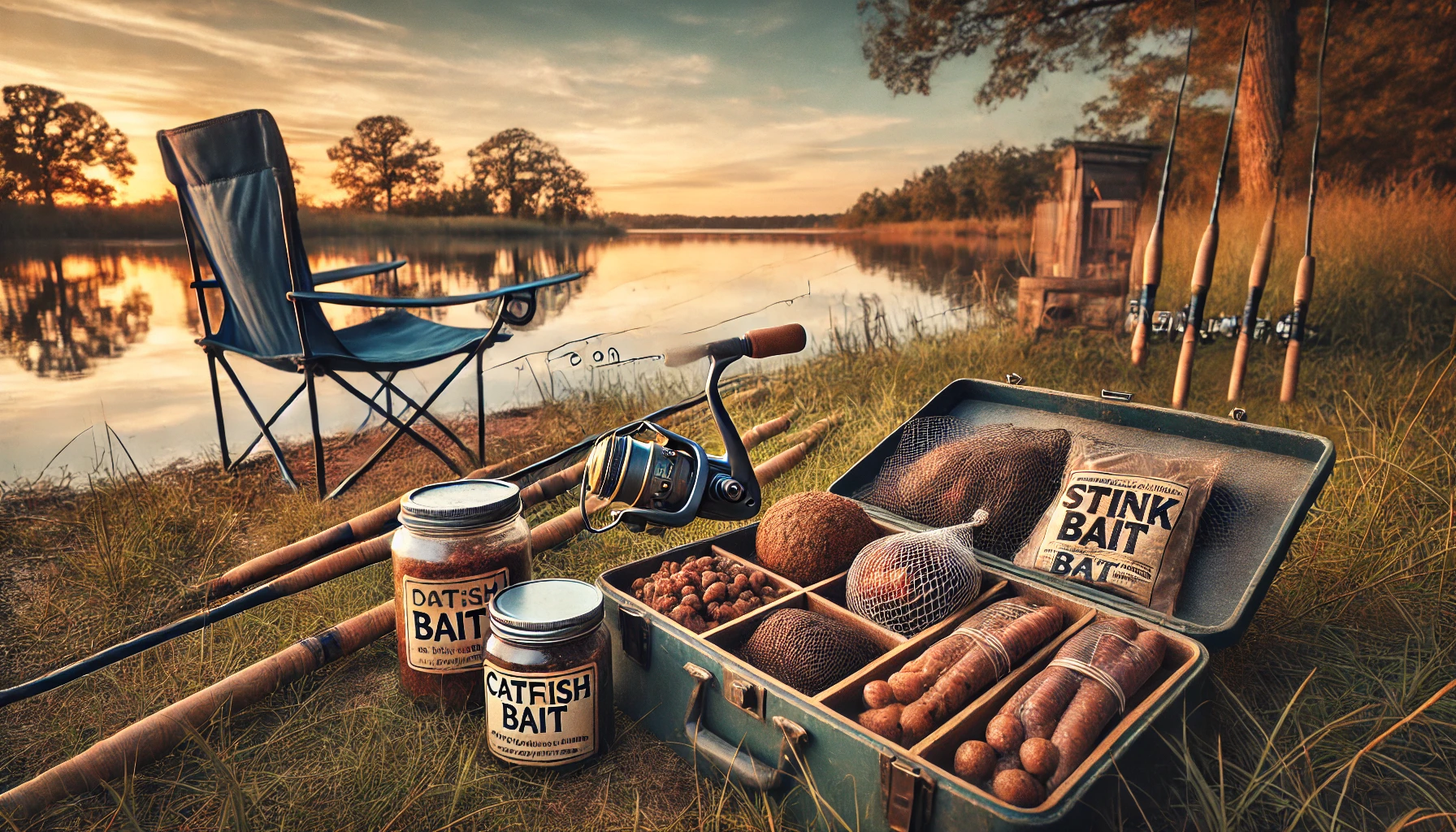GUIDE
Catfish Bait That Consistently Delivers Results

Whether you’re new to fishing or have been dropping lines for decades, one thing is certain — your bait choice can make or break your catfish trip. These bottom-dwelling giants have a legendary sense of smell and taste, and knowing how to use the right bait puts you far ahead of the average angler.
In this guide, we’re diving deep into the world of catfish bait, breaking down what works, why it works, and how to use it effectively. From stink bait to live bait, we’re covering it all in a way that’s both beginner-friendly and packed with pro tips.
Why Catfish Are a Unique Catch
Before choosing bait, it helps to understand your target. Catfish aren’t your average fish. They don’t rely heavily on eyesight — instead, their barbels (those whisker-like feelers) are packed with sensory cells. In other words, they hunt with their nose.
That’s why smelly, oily, or even downright gross bait tends to outperform shiny lures. If you want to catch more catfish, focus on scent and flavor first, and presentation second.
Types of Catfish: Preferences Matter
Not all catfish chase the same meals. Here’s how to bait smarter by species:
Channel Catfish
These guys are opportunistic feeders. They love strong smells and will eagerly bite stink bait, blood bait, and chicken liver.
Flathead Catfish
Flatheads are predators, so live bait like sunfish or bullhead catfish works best. They prefer a moving target over something smelly.
Blue Catfish
Big blues enjoy fresh cut bait. Think freshly chopped shad or skipjack — not something left out in the sun too long.
Knowing which type you’re targeting helps narrow down your bait choices, increasing your success rate instantly.
Natural Baits That Get the Job Done
Mother Nature has given us plenty of bait that catfish can’t resist. Here are some top picks:
Cut Bait
This is a classic go-to. Cut pieces of fish like shad, carp, or herring release oils and blood that catfish hone in on. For best results, use freshly cut bait, not stuff that’s been sitting in your freezer for a year.
Live Bait
Ideal for flathead catfish. Use bluegill, creek chubs, or goldfish (where legal). Hook them through the back or tail for natural movement.
Worms and Nightcrawlers
Simple and effective. Nightcrawlers wriggle enticingly and have a strong earthy scent, especially useful in muddy water.
Chicken Liver
Sticky and strong-smelling, this is a channel cat favorite. You can even tie it in pantyhose to keep it from falling off the hook.
Homemade Catfish Baits: DIY That Works
Want to save money and still crush it on the water? Try these homebrew baits:
Stink Bait
Mix cheese, garlic, chicken liver, and fish oil in a jar. Let it “age” for a few days — yes, it’ll smell terrible. But catfish love it.
Dough Balls
Blend flour, cornmeal, minced shrimp, and vanilla extract. Form into balls and let them dry slightly before hooking.
Soap Bait
Some swear by Ivory or Zote soap cubes, especially in warm water. It sounds strange, but the fish-oil base attracts catfish surprisingly well.
Top Store-Bought Catfish Baits
If making your own bait isn’t your thing, don’t worry — there are great options on the shelf.
Dip Baits
These are gooey, sticky, and packed with scent. Use a sponge or bait holder to apply. Top picks: Sonny’s Super Sticky or Team Catfish Secret-7.
Punch Baits
Thicker than dip baits, they cling directly to a treble hook. Great for bank fishing or when casting far.
Pre-Formed Dough Baits
Clean and easy to use. Just press one onto a hook and cast.
Many commercial baits are formulated for maximum scent dispersion, making them ideal for rivers or lakes with current.
When to Use What Bait: Seasonal Strategies
Just like people, catfish change their habits depending on the season.
Spring
They’re hungry and shallow. Use cut bait and worms near cover like submerged logs.
Summer
Catfish move deep and get picky. Go with stink baits or live bait during low light hours.
Fall
They’re fattening up for winter. Use large cut bait or big live fish for trophy catches.
Winter
Things slow down. Target deep holes with slow-moving bait like suspended shad chunks.
Matching bait to season gives you an edge most casual fishers miss.
Mistakes to Avoid When Using Catfish Bait
Even experienced anglers slip up sometimes. Here are a few baiting blunders to avoid:
-
Using spoiled bait: There’s a fine line between smelly and unusable.
-
Putting scentless bait in muddy water: Visibility is low; scent is king here.
-
Choosing the wrong hook: Treble hooks don’t work well with live bait, and single hooks may not hold dough bait properly.
Remember: catfish are picky, so presentation and freshness count.
Pro Tips That Improve Catch Rates
You’ve got the bait — now dial in your technique with these tips:
-
Switch bait every 20–30 minutes if you’re not getting bites.
-
Use a bait scent enhancer spray, especially in fast-moving rivers.
-
Keep multiple bait types on hand — what works in the morning might flop in the afternoon.
And always stay flexible. Weather, water temp, and barometric pressure can influence feeding.
Testing and Tracking Your Bait Results
Smart anglers treat every trip like research.
-
Keep a bait journal: Note the water temp, bait used, and results.
-
Try new combos: Don’t be afraid to pair odd scents — anise and garlic, for example.
-
Use a bait rotation: Start with fresh bait, then test commercial or stink options.
Over time, you’ll build a bait strategy tailored to your waters and your fish.
Bank vs. Boat: Does Bait Change?
Yes! Where you fish affects what works.
Bank Fishing
You need bait that sticks on long casts — punch bait or sturdy cut bait is ideal.
Boat Fishing
More control, so you can use delicate baits like chicken liver or soft dough balls right over prime locations.
Adapt your approach and you’ll land more fish in both scenarios.
Also read: Submodica: Enhancing Subnautica Through Community-Driven Modding
Conclusion
At the end of the day, success in catfishing often comes down to this: choose the right bait, use it smartly, and stay patient. Whether you prefer the DIY route or go with top-tier commercial options, understanding the species, season, and conditions will guide your choices.
Remember, catfish hunt with their noses, not their eyes. That means your bait needs to hit their senses hard — scent first, movement second.
Try different styles, log your results, and before you know it, you’ll be the one giving out advice at the boat ramp.
FAQs
What is the best overall catfish bait?
That depends on the species, but cut bait and stink bait are top choices for many situations.
Is homemade catfish bait better than store-bought?
Not necessarily. Homemade bait can be cheaper and more customizable, but commercial bait is more convenient and consistent.
How do I keep chicken liver on the hook?
Wrap it in pantyhose or use a liver hook to keep it secure during casts.
Can I use artificial lures for catfish?
Yes, but results are mixed. Catfish usually respond better to scent-rich natural baits.
How often should I change bait?
If you haven’t had a bite in 20–30 minutes, it’s time to change bait or move spots.

-

 EDUCATION3 months ago
EDUCATION3 months agoFree Cover Letter Generator: Build Job-Winning Letters in Minutes
-

 GUIDE3 months ago
GUIDE3 months agoBenefits of Online Personal Training for Fitness Success
-

 BUSINESS3 months ago
BUSINESS3 months agoGrow Your Audience with USA Instagram Followers
-

 TECH2 months ago
TECH2 months agoFreedom Forever Solar Reviews Explain How Conversational Intelligence Turns Customer Interactions into Insights